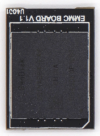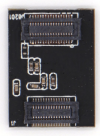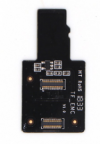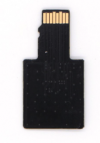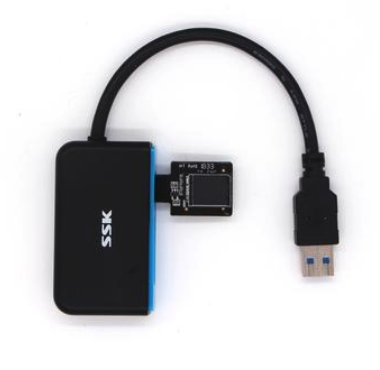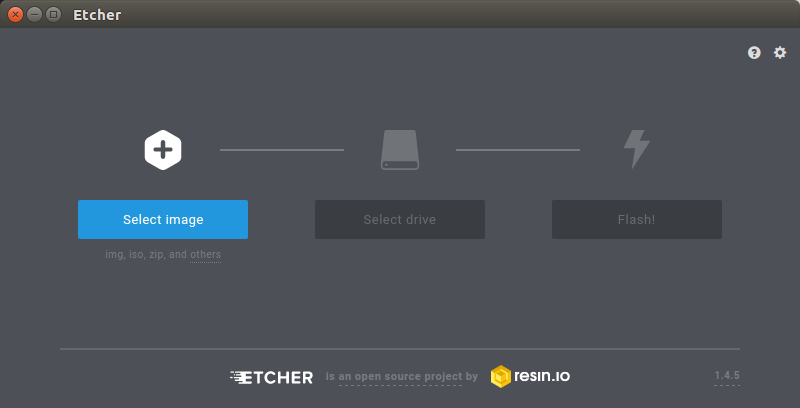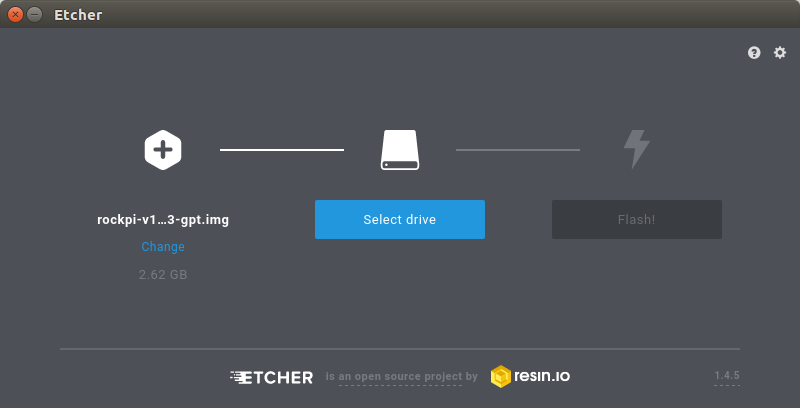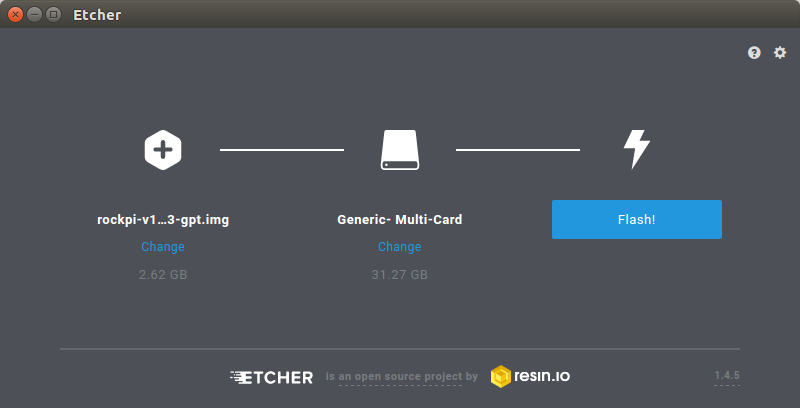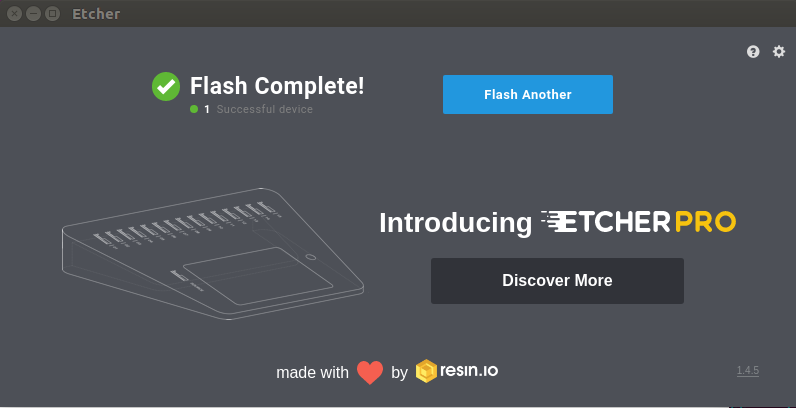Difference between revisions of "Rockpi4/install/eMMC"
(Added note about SPI interference in booting from eMMC) |
|||
| Line 14: | Line 14: | ||
$ sudo /usr/local/sbin/rockpi4b_erase_spi_flash.sh | $ sudo /usr/local/sbin/rockpi4b_erase_spi_flash.sh | ||
| + | |||
| + | === Option 1: With PC and eMMC adapter === | ||
====Step1: Requirements ==== | ====Step1: Requirements ==== | ||
| Line 19: | Line 21: | ||
This page describe how to download and install the image on an eMMC module and boot on ROCK Pi 4. You need at least the following. | This page describe how to download and install the image on an eMMC module and boot on ROCK Pi 4. You need at least the following. | ||
| − | * an eMMC module, you can buy it from radxa distributor, the eMMC module from Odroid or PINE64 also works on ROCK Pi 4. [[File:Emmc_module_top.png | 100px]] [[File:Emmc_module_bottom.png | 100px]] | + | * an eMMC module, you can buy it from radxa distributor, the eMMC module from Odroid or PINE64 also works on ROCK Pi 4. |
| − | * an eMMC to microSD breakout board [[File:Emmc_to_microSD_breakout_top.png | 100px]] [[File:Emmc_to_microSD_breakout_bottom.png | 100px]] | + | [[File:Emmc_module_top.png | 100px]] [[File:Emmc_module_bottom.png | 100px]] |
| + | |||
| + | * an eMMC to microSD breakout board | ||
| + | [[File:Emmc_to_microSD_breakout_top.png | 100px]] [[File:Emmc_to_microSD_breakout_bottom.png | 100px]] | ||
| − | If you do not have an eMMC to μSD card converter board, you can also first install a linux system (e.g.: Debian) to a μSD Card (see [[Rockpi4/install/microSD]]) and then use the running Linux μSD System to install the desired system to the eMMC card with the eMMC card already inserted into the Rock PI 4. See below. | + | If you do not have an eMMC to μSD card converter board, you can also first install a linux system (e.g.: Debian) to a μSD Card (see [[Rockpi4/install/microSD]]) and then use the running Linux μSD System to install the desired system to the eMMC card with the eMMC card already inserted into the Rock PI 4. See below [[#Option_2:_With_ROCK_Pi | Option 2]]. |
* a microSD card reader, either a USB card reader or the SD card reader on laptop | * a microSD card reader, either a USB card reader or the SD card reader on laptop | ||
| − | * | + | * a PC/laptop running Windows or Linux or MacOS |
You also need the following to run on ROCK Pi 4 | You also need the following to run on ROCK Pi 4 | ||
| Line 45: | Line 50: | ||
====Step 3: Write the image to eMMC Module ==== | ====Step 3: Write the image to eMMC Module ==== | ||
| − | + | 1 Plug and click the eMMC module to the eMMC to uSD breakout board, plug the breakout board to microSD card reader. Plug the card reader on PC. | |
[[File:Emmc_module_on_card_reader.png]] | [[File:Emmc_module_on_card_reader.png]] | ||
| − | + | 2 Run the application, for example, by executing the command on Ubuntu 16.04: | |
$ /bin/bash etcher-etcher-electron-1.4.5-x86_64.AppImage | $ /bin/bash etcher-etcher-electron-1.4.5-x86_64.AppImage | ||
| − | + | 3 In the etcher window, we click button Select image. | |
[[File:linux_etcher_select_image.png]] | [[File:linux_etcher_select_image.png]] | ||
| − | + | 4 In the etcher window, we click button Select Drive. | |
[[File:linux_etcher_select_driver.png]] | [[File:linux_etcher_select_driver.png]] | ||
| − | + | 5 In the etcher window, we click button Flash. | |
[[File:linux_etcher_select_flash_button.png]] | [[File:linux_etcher_select_flash_button.png]] | ||
| − | + | 6 In the etcher window, it shows us Flash Complete! | |
[[File:linux_etcher_show_complete.png]] | [[File:linux_etcher_show_complete.png]] | ||
| Line 71: | Line 76: | ||
Done! Now you have successfully installed the OS image on eMMC module. | Done! Now you have successfully installed the OS image on eMMC module. | ||
| − | === | + | === Option 2: With ROCK Pi === |
| − | + | ==== Requirements ==== | |
| − | Verify that the system has booted from μSD, which should be /dev/mmcblk0p5 and that the eMMC module is found as /dev/mmcblk1: | + | * uSD card, for booting on ROCK Pi |
| + | * ROCK Pi 4 board with power supply | ||
| + | * HDMI cable for display | ||
| + | * USB keyboard and mouse for input | ||
| + | |||
| + | |||
| + | ====Write the image to eMMC Module on ROCK Pi==== | ||
| + | |||
| + | If you have no eMMC to μSD card converter board, install Debian Linux (or another Linux variant) first to μSD following the [[Rockpi4/install/microSD | uSD install page]]. Insert both your μSD and the (empty) eMMC module into the Rock PI 4. Reboot it. It will boot from μSD. You can now use that Linux on ROCK Pi to download your desired OS from [[Rockpi4/downloads]] and install it onto the eMMC module. Example: | ||
| + | |||
| + | Verify that the system has booted from μSD, which should be '''/dev/mmcblk0p5''' and that the eMMC module is found as '''/dev/mmcblk1''': | ||
$ dmesg | grep mmcblk | $ dmesg | grep mmcblk | ||
| Line 86: | Line 101: | ||
Then write your downloaded OS image to eMMC: | Then write your downloaded OS image to eMMC: | ||
| − | dd if=rockpi4_debian_stretch_lxde_armhf_20181105_2120-gpt.img of=/dev/mmcblk1 | + | $ sudo dd if=rockpi4_debian_stretch_lxde_armhf_20181105_2120-gpt.img of=/dev/mmcblk1 |
| + | |||
| + | If you image downloaded is img.xz format, it's compressed, use | ||
| + | |||
| + | $ sudo xzcat rockpi-4cplus-ubuntu-focal-server-arm64-20220520-1242-gpt.img.xz | dd of=/dev/mmcblk1 bs=1M | ||
A CLI tool to write an image with write diagnostics is pv: | A CLI tool to write an image with write diagnostics is pv: | ||
| − | $ apt install pv | + | $ sudo apt install pv |
| − | $ pv -ptera < rockpi4_debian_stretch_lxde_armhf_20181105_2120-gpt.img | dd of=/dev/mmcblk1 | + | $ sudo pv -ptera < rockpi4_debian_stretch_lxde_armhf_20181105_2120-gpt.img | dd of=/dev/mmcblk1 bs=1M |
Power off your Rock PI 4, remove the μSD and power on again. The system will now boot from the eMMC module. | Power off your Rock PI 4, remove the μSD and power on again. The system will now boot from the eMMC module. | ||
| − | |||
| − | |||
Revision as of 02:41, 12 June 2022
ROCK Pi 4 > Install > Install on eMMC module
Contents
Possible Issues
RockPI4 v1.4 with SPI installed may have bootstrap code which is executed in before eMMC boostrap. This SPI bootstrap code may not be able to then boot third-party OS on eMMC, for example when booting an OS using MBR partition table instead of GUID partition table used by Radxa provided images. One example is the Armbian image on Rockpi4/downloads which uses MBR.
To overcome this issue, SPI bootstrap code can be disabled by connecting GPIO pins 23 with 25.
Alternatively, boot the Radxa version of debian from the download page from uSD and then excute:
$ sudo /usr/local/sbin/rockpi4b_erase_spi_flash.sh
Option 1: With PC and eMMC adapter
Step1: Requirements
This page describe how to download and install the image on an eMMC module and boot on ROCK Pi 4. You need at least the following.
- an eMMC module, you can buy it from radxa distributor, the eMMC module from Odroid or PINE64 also works on ROCK Pi 4.
- an eMMC to microSD breakout board
If you do not have an eMMC to μSD card converter board, you can also first install a linux system (e.g.: Debian) to a μSD Card (see Rockpi4/install/microSD) and then use the running Linux μSD System to install the desired system to the eMMC card with the eMMC card already inserted into the Rock PI 4. See below Option 2.
- a microSD card reader, either a USB card reader or the SD card reader on laptop
- a PC/laptop running Windows or Linux or MacOS
You also need the following to run on ROCK Pi 4
- ROCK Pi 4 board with power supply
- HDMI cable for display
- USB keyboard and mouse for input
Step 2: Download necessary tools and image
- Etcher is the tool we use to write image. Download the right Etcher for your PC from Rockpi4/downloads page and install it. Check [Etcher website] for more info about Etcher.
- Choose the image you want to install from Rockpi4/downloads page and unzip it. The unzipped image name is like below:
rockpi4_debian_stretch_lxde_armhf_20181105_2120-gpt.img
We will use it for the writing.
Step 3: Write the image to eMMC Module
1 Plug and click the eMMC module to the eMMC to uSD breakout board, plug the breakout board to microSD card reader. Plug the card reader on PC.
2 Run the application, for example, by executing the command on Ubuntu 16.04:
$ /bin/bash etcher-etcher-electron-1.4.5-x86_64.AppImage
3 In the etcher window, we click button Select image.
4 In the etcher window, we click button Select Drive.
5 In the etcher window, we click button Flash.
6 In the etcher window, it shows us Flash Complete!
Done! Now you have successfully installed the OS image on eMMC module.
Option 2: With ROCK Pi
Requirements
- uSD card, for booting on ROCK Pi
- ROCK Pi 4 board with power supply
- HDMI cable for display
- USB keyboard and mouse for input
Write the image to eMMC Module on ROCK Pi
If you have no eMMC to μSD card converter board, install Debian Linux (or another Linux variant) first to μSD following the uSD install page. Insert both your μSD and the (empty) eMMC module into the Rock PI 4. Reboot it. It will boot from μSD. You can now use that Linux on ROCK Pi to download your desired OS from Rockpi4/downloads and install it onto the eMMC module. Example:
Verify that the system has booted from μSD, which should be /dev/mmcblk0p5 and that the eMMC module is found as /dev/mmcblk1:
$ dmesg | grep mmcblk ... [...] EXT4-fs (mmcblk0p5): mounted filesystem with ordered data mode. $ ls -l /dev/mmcblk1 brw-rw---- 1 root disk 179, 0 Jan 6 13:25 /dev/mmcblk1
Then write your downloaded OS image to eMMC:
$ sudo dd if=rockpi4_debian_stretch_lxde_armhf_20181105_2120-gpt.img of=/dev/mmcblk1
If you image downloaded is img.xz format, it's compressed, use
$ sudo xzcat rockpi-4cplus-ubuntu-focal-server-arm64-20220520-1242-gpt.img.xz | dd of=/dev/mmcblk1 bs=1M
A CLI tool to write an image with write diagnostics is pv:
$ sudo apt install pv $ sudo pv -ptera < rockpi4_debian_stretch_lxde_armhf_20181105_2120-gpt.img | dd of=/dev/mmcblk1 bs=1M
Power off your Rock PI 4, remove the μSD and power on again. The system will now boot from the eMMC module.

